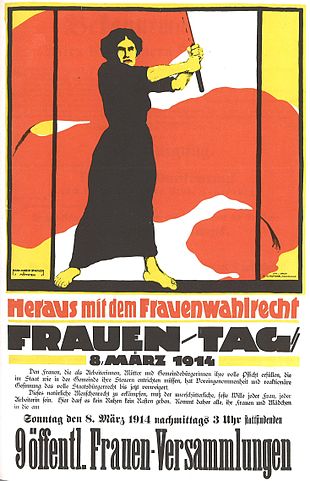 The first National Women’s Day observance was organized by the Socialist Party of America, and was held on February 28, 1909 in New York. The original purpose was to serve as a remembrance of the strike of the International Ladies Garment Worker’s Union that occurred in 1908. As assemblies of women worldwide picked up on the idea, the earliest gatherings on International Women’s Day were mostly organized and supported by the socialist and communist movements.
The first National Women’s Day observance was organized by the Socialist Party of America, and was held on February 28, 1909 in New York. The original purpose was to serve as a remembrance of the strike of the International Ladies Garment Worker’s Union that occurred in 1908. As assemblies of women worldwide picked up on the idea, the earliest gatherings on International Women’s Day were mostly organized and supported by the socialist and communist movements.
In August 1910, an International Women’s Conference was established as an event that preceded the general meeting of the Second Socialist International Conference in Copenhagen, Denmark. One hundred women from 17 countries met at the conference to demand equal rights for women, including a campaign for women’s suffrage. A disagreement developed between English delegates who were in favor of working with “bourgeois” feminists to secure a piecemeal expansion of suffrage and the left-leaning Germans, who felt it would be better to merge the proletarian woman’s movement into a larger working class struggle to gain universal suffrage. Nevertheless, at this conference, Luise Zietz and Clara Zetkin proposed the idea of an international day of protest for women’s rights, which later was designated as International Women’s Day. The following year in February 1911, at least a million women in Europe marched in support of gaining the right to vote in their countries’ elections, the end to gender discrimination in employment, and the ability to run for political office.
In February 1913, Russians first began observing International Women’s Day, honoring the contributions of women to society. Then in 1917, Russian women marked International Women’s Day by going on strike for “bread and peace” to demand an end to World War I and food shortages. This helped instigate the February Revolution in St. Petersburg, provoking eight days of general strikes, mass demonstrations and armed conflict with the police. Following the end of the Russian Revolution, Lenin made International Women’s Day an official holiday in the Soviet Union, but without time off from work. In 1965, by the decree of the USSR Presidium of the Supreme Soviet, International Women’s Day was declared a non-working holiday in Russia to commemorate the outstanding contributions of women “in communistic construction in the defense of their Fatherland during the Great Patriotic War.” From discussions with my counterparts in Russia, back when I was traveling to Moscow on business somewhat frequently, I learned that International Women’s Day is still a popular and well-respected holiday.
For many years, International Women’s Day was mostly adopted by communists, including China beginning in 1922 and by Spanish communists after 1936. In more recent history, some Western countries used the celebration to emphasize the many contributions of women during World War II. Eleanor Roosevelt even praised such observances of the unity of women worldwide in “My Day,” her daily newspaper column, in 1944. The United Nations designated 1975 as International Women’s Year, and began sponsoring and promoting International Women’s Day. As it became more widely recognized in the West, the United Nations invited nations to proclaim March 8th as the universal UN day of support for women’s rights and world peace.
Although not an official holiday in the US, International Women’s Day on March 8th is still a good occasion to honor the social and economic contributions of women on the international level and to continue to advocate for the equality of women across the globe. The United Nations continues to promote International Women’s Day, organized around a different theme every year. This year, for 2017, the theme is “Be Bold for Change,” which seems like a challenge we should all take up.
Image: 1914 Women’s Day Poster – Wikimedia Commons – public domain.















4 Comments
Leave your reply.